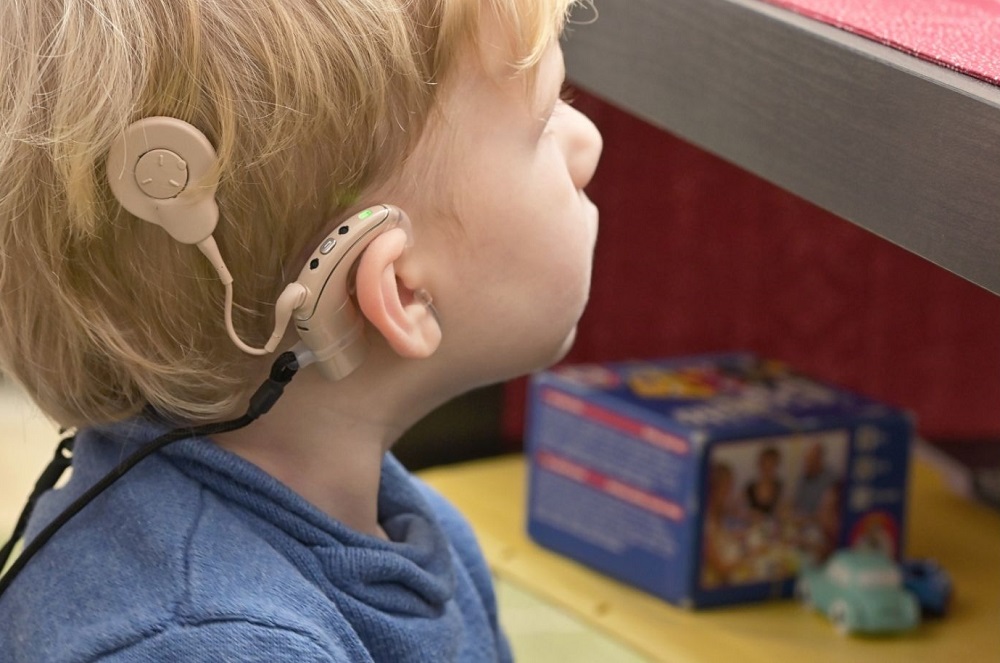A cochlear implant is a surgically implanted device that gives a heightened sense of sound to somebody with hearing loss.
The cochlear implant was first invented in 1957 and is widely used to this day. It is used as an alternative to hearing aids for extremely hard-of-hearing people or who want reliable assistance in hearing.

Some History into the Cochlear Implant
The cochlear implant was invented in 1957 by André Djourno and Charles Eyriès. The first invention of the implant sent stimulation through the ear in a single channel. American otologist and physician William House invented a cochlear implant in 1961.
Blair Simmons and Robert White created a single-channel electrode in a cochlea, but this was proved to be of limited beneficial use because it could not pick up higher and lower frequencies simultaneously, which is a part of detecting speech. Cochlear implants were invented and developed by these scientists over time.
In the mid-’70s, a NASA engineer named Adam Kissiah worked on what may have been known as the modern cochlear implant. Adam was hard of hearing and was dissatisfied with regular hearing aids, which is what made him put so much research into his cochlear implant.
His research was surprisingly not based upon medical research, but instead electronic engineering due to his job as an electronics instrumentation engineer at NASA. NASA assisted Kissiah in obtaining a patent for his invention, and years later, he sold the rights to a company named BIOSTIM. This company is no longer in business, but several companies have applied his concept to new cochlear implant inventions.
The modern and widely-used multi-channel cochlear implant was created and manufactured by two companies, Graeme Clark in Australia and Ingeborg Hochmair in Austria. Hochmair’s device was the first to be implanted in a person in 1977. This is the base of the cochlear implant we know today.
The implant was the first microelectronic implant and had a flexible electrode that could deliver signals to the auditory nerve for the first time. It has eight channels and a high stimulation rate, meaning it helps people who are hard of hearing with realistic sounds and sensations.
The research extended in 1980, and people with the implant could now differentiate and understand words and sentences without lip-reading! From then, devices were implanted in adults and children, and in 1991 the first behind-the-ear processor for an implant was designed for optimal comfort.
How Does It Work?
The cochlear implant bypasses the natural acoustic auditory process and replaces it with electrical signals which directly stimulate the auditory nerve. The signals are sent to the inner ear part named the cochlea. This part of the ear is a snail-shaped organ that contains fluid and moves in response to vibration. This vibration then translates into electrical impulses, which are sent to the brain.
It is not a restorative hearing implant but a tool to send sound and speech to the brain. It does not help people hear normally but translates audio to the brain differently for deaf and hard of hearing people.
It has been said that people with the implant receive audio in robotic voices, buzzing, beeping, and echoing sounds. Because it is a hearing device, the sound does not translate entirely accurately to the brain, but it is hugely beneficial for hard-of-hearing people.
Is It Permanent?
A cochlear implant is a surgically implanted device meaning it should last a lifetime. It is only recommended for people with severe, permanent hearing loss, which cannot be assisted by hearing aids. As it is surgically implemented, it is not supposed to be removed. It sends signals to the brain, and once you have it, it should not be removed.
How Effective Is A Cochlear Implant?
Cochlear implants are some of the most successful inventions. The rate of patients rejecting the surgery and implant is 0.2% and the likelihood of it failing or needing to be replaced is 0.5%!
Patients usually benefit immediately after having surgery, and their hearing continues to improve over time.
People are able to perceive and differentiate different frequencies of sound and pitches. Patients can perceive footsteps, engines, telephones, barking, and small details that are unexpected for hearing loss.
It has also been noted that people can understand speech without having to lip-read since the progression of technology in the 1980s. The way the electrode translates sound into frequencies within the cochlear makes it an effective hearing loss repair.
Patients can essentially live everyday life and watch television, listen to music, and use the phone. Although it is not the same as people without hearing loss, it has been said it is more effective than hearing aids, especially for people with severe hearing loss.
How does it stay in the ear?
A surgical procedure implants it. This procedure is called a mastoidectomy. It is carried out under anesthesia, and there can be risks of the implant moving and there being damage to the facial nerve.
However, the chance of complications is around 3%. The surgery consists of a small incision behind the ear. The implant is placed inside the incision, and the electrode is inserted into the cochlea in the inner ear. It is a fairly simple and low-risk procedure and has been carried out many times.
There is an alternative surgical technique where surgeons go through the suprameatal triangle instead of the cochlea, and it is inserted through the skull.
What Types of Implants Are There?
There is only one type of cochlear implant, but they are manufactured by different companies and used in children and adults for years. The most common companies are Cochlear, Advanced Bionics, and Medel.
Although there is only one type of cochlear implant, there are other types of hearing implants. This includes bone conduction devices, auditory brain stem implants, and middle ear implants. There are obvious benefits from each of these implants, yet cochlear implants are the most common and are regarded as one of the most successful.
